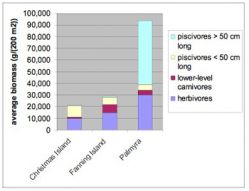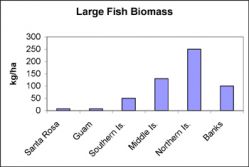Extracted from Dr. Douglas Fenner's full-length article here.
Many reef scientists have spent their entire careers diving on reefs that have few big fish, and have never questioned whether that was normal or natural. It is very easy to assume that reefs have always been the way that we first saw them, and judge their future condition based on that. As reefs degrade, each generation uses a lower condition as the baseline to judge further losses. This is called the "shifting baseline"1,2
Observations over time can be more powerful in countering shifting baselines. In the Philippines, in two years of about 10 dives a week, I saw about a total of about five sharks, and two of those were on the way to the market. A few years later I got to dive at Tubbataha reefs in the Philippines, which are remote and currently protected. Whitetip reef sharks were not uncommon there, though nothing like grey reef sharks on the truly remote reefs that have not been fished.
There are many differences between islands other than the intensity of fishing, which could produce these differences. However, in spite of all of the other differences, nearly every reef with people nearby has very few big fish left, and virtually every remote pristine reef that has been studied has high levels of these fish.
 When renowned coral reef scientist J.E.N “Charlie” Veron first started working on Australia’s Great Barrier Reef, he writes that there was always a moment of anxiety after rolling backwards off the side of a boat to for a dive. “We all felt that. We waited for the bubbles to clear just to make sure that there wasn't a big tiger among the sharks that always gathered around.”
When renowned coral reef scientist J.E.N “Charlie” Veron first started working on Australia’s Great Barrier Reef, he writes that there was always a moment of anxiety after rolling backwards off the side of a boat to for a dive. “We all felt that. We waited for the bubbles to clear just to make sure that there wasn't a big tiger among the sharks that always gathered around.”
“Now,” he writes, “anywhere in the Asian region, I swim long distances over deep water without the slightest concern, for there are virtually no sharks left, big or small. I haven't even seen big fish in any numbers around an Asian reef in years. The plight of sharks is symptomatic of what is happening to reefs."
Median rates of sharks in the Great Barrier Reef have plummeted at a 7% drop a year for whitetip reef sharks and a 17% decrease a year in grey reef sharks3. Even areas were people are allowed to go but not fish are showing drops in shark populations. It seems that people are poaching sharks in no-take Marine Protected Areas. In Australia it is only no-go areas where fishing is banned, such as Australia’s Cocos-Keeling Islands that have sharks in any number.

The Republic of Kiribati is made up of 33 Pacific islands and atolls, with the majority of the population and fisheries based around the largest island, Kiritimati or Christmas Island. The earliest historical descriptions of Kiritimati and its second-largest island Tabuaeran, or Fanning Island document an enormous abundance of sharks and other large fish.
Yet a 2008 study of the islands found a startling decline in fish biomass, with a 50% drop since 1997. Large declines in fish had occurred within just ten years as fishing increased with population size. Thus, the low fish biomass at these atolls is most likely is due to fishing here, as in many places elsewhere4.
The contrast with the outer reefs is also striking. At Christmas Island where fishing is heaviest, studies found no large predators and mainly small herbivorous fish. At Palmyra, where fishing is lightest more than half of the fish biomass was in large sharks and fish5.

In Guam, human population is concentrated on the main island of Guam and the southern island of Santa Rosa, while the middle and northern islands are uninhabited. Studies of reef fish in Guam and the Marianas found that fish larger than 20 inches in length were much more abundant around the islands at the northern end of the chain15.
Fishing has long been known to usually remove the big fish first6-10. The incentive is for a fisher to go for the big ones: more to feed your family or more to sell. One fisherman's response to hearing that there were many more big fish at the northern end of the chain was "maybe that's where we should hold our fishing tournament next year!"

Grey reef sharks and Galapagos sharks are the most common predators in Hawaiian waters, yet when you visit any of the main islands there are very few, if any, sharks in the water. I have snorkeled a lot in the main Hawaiian Islands (and wrote a book on Hawaiian corals, "Corals of Hawaii"), but has only ever seen one or two sharks there. If you snorkel or dive in Hawaii, you will only be surrounded by beautiful small fish. That is very different from a natural reef and is typical of reefs near people where fishing is prevalent.
But go beyond the main islands and you see a different story. The northwest islands are virtually swarming with big fish in comparison to the main islands.11 Amazingly, sharks and other large fish compose around half of all the weight, otherwise known as biomass, of all the fish on these reefs while the main islands have few, if any sharks at all12. There are about 65 times as many sharks per unit of area in the Northwest Hawaiian Islands as the main islands.

Studies in the remote and un-fished reefs in the Line Islands south of Hawaii have also found that unlike the main islands of Hawaii, half of the fish biomass is in big fish4,5,13,14. And unlike the one shark that you may see after diving on a reef near people, in the remote Phoenix Islands fish expert Dr. Gerry Allen reported seeing an average of 15 sharks after diving for only one hour.
1 - Pauly, D. 1995. Anecdotes and the shifting baseline syndrome of fisheries. Trends in Ecology and Evolution 10: 430.Sheppard 1995
2 - Sheppard, C. 1995. The shifting baseline syndrome. Marine Pollution Bulletin 30: 766-767.
3 - Robbins, W. D., Hizano, M., Connolly, S. R., J. H. Choat. 2006. Ongoing collapse of coral-reef shark populations. Current Biology 16: 2314-2319.
4 - Sandin, S., A., Smith, J. E., DeMartini, E. E., Dinsdale, E. A., Donner, S. D., Friedlander, A. M., Konotchick, T., Malay, M., Maragos, J. E., Obura, D., Pantos, O., Paulay, G., Richie, M., Rohwer, M., Schroeder, R. E., Walsh, S., Jackson, J. B. C., Knowlton, N., Sala, E. 2008. Baselines and degradation of coral reefs in the Northern Line Islands. PLOS One 3(2): 1-11.
5 - Stevenson, C., Katz, L. S., Micheli, L. F., Block, B., Heiman, K. W., Perle, C., Weng, K., Dunbar, R., Witting, J. 2006. High apex predator biomass on remote Pacific Islands. Coral Reefs 26: 47-51.
6 - Ricker, W. E. 1946. Production and utilization of fish populations. Ecological Monographs 16: 373-391.
7 - Jennings, S., Kaiser, M. (1998) The effects of fishing on marine ecosystems. Advances in Marine Biology 34: 201-
8 - Jennings, S., Reynolds, J. D., and Polunin, N. V. C. 1999. Predicting the vulnerability of tropical reef fishes to exploitation with phylogenies and life histories. Conservation Biology 13: 1466-1475.
9 - Pitcher, T. J. 2001. Fisheries managed to rebuild ecosystems? Reconstructing the past to salvage the future. Ecological Applications 11: 601-617
10 - Dulvy, N. K., Polunin, N. V. C. 2004b. Size structural change in lightly exploited coral reef fish communities: evidence for weak indirect effects. Canadian Journal of Fisheries and Aquatic Sciences 61: 466-475.
11 - Friedlander, A. and De Martini, E. E. 2002. Contrasts in density, size, and biomass of reef fishes between the northwestern and main Hawaiian Islands: effects of fishing down apex predators. Marine Ecology Progress Series 230: 253-264.
12 - Birkeland, C. and Friedlander, A. M. 2001. The importance of refuges for reef fish replenishment in Hawai'i. Hawaii Audubon Society, 19 pp.
13 - Pala, C. 2007a. Conservationists and fishers face off over Hawaii's marine riches. Science 317: 306-307.
14 - Richie, M., Rohwer, M., Schroeder, R. E., Walsh, S., Jackson, J. B. C., Knowlton, N., Sala, E. 2008. Baselines and degradation of coral reefs in the Northern Line Islands. PLOS One 3(2): 1-11.
15 - Starmer, J., Asher, J., Castro, F., Gochfeld, G., Gove, J., Hall, A., Houk, P., Keenan, E., Miller, J., Moffit, R., Nadon, M., Schroeder, R., Smith, E., Trianni, M., Vroom, P., Wong, K., and Yuknavage, K. 2008. The state of coral reef ecosystems of the Commonwealth of the Northern Mariana Islands. Pages 427-463 in Waddell, J. E. and A. M. Clarke (eds.) The state of coral reef ecosystems of the United States and Pacific Freely Associated States: 2008. NOAA Technical Memorandum NOS NCCOS 73.
16 - Wilkinson, C. (ed.) 2008. Status of coral reefs of the world: 2008. Global Coral Reef Monitoring Network, Townsville, Australia. 298 pp.